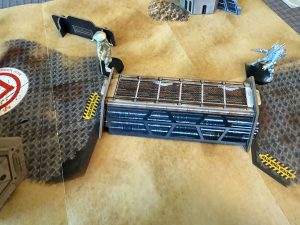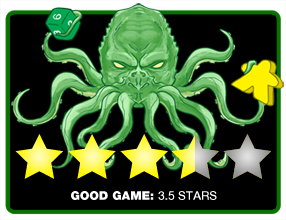 I enjoy a good science-fiction skirmish game. Technology replaces magic and super powers, allowing you to experience a world that can be as fantastical as any fantasy world, grim dark, political, or anywhere in between.
I enjoy a good science-fiction skirmish game. Technology replaces magic and super powers, allowing you to experience a world that can be as fantastical as any fantasy world, grim dark, political, or anywhere in between.
I also like miniatures games and pushing dudes, dudettes, and monsters/mechs around a map.
Infinity is a miniatures-based skirmish wargame set in a science fiction world where several factions battle for control of resources and locations. You know you’re in a sci-fi world of mega corporations because of all of the TLA’s (Three Letter Acronyms) in the lore and the rules.
Gameplay Overview:
Much of the gameplay will be familiar to wargamers as you move units using rulers or tape measures, check line of sight, and attack with dice rolls. And while the very basic rules included could easily be summarized, I’m going to link the full rules, which are needed if you want to know how to deal with terrain, ammo, adding more skills, etc. The starter rules are basic, but if you incorporate all the rules, get ready for a crunchy experience.

In each round, each team will have as many orders as they have active figures on the board. These orders are generally move and attack, and each activation order will allow a character to take two basic short skills or a basic short skill and a short skill.
Where the game goes from a march to a strut is with the ARO – Automatic Reaction Orders. Those allow opponents to interrupt your actions with their own action. These are most commonly shooting at a target that pops into view.
Combat uses a d20 system where you need to roll under the target number. When taking a Ballistic Skill (BS) Attack, the shooter gets to roll as many d20’s as their weapon’s Burst (B) value. The number to hit is their BS skill modified for range and cover. If you hit, the target gets to roll a saving roll (SR) to see if their armor worked. The SR is the target’s armor value (ARM) plus the weapon’s Possibility of Survival (PS) rating plus 3 if the target had partial cover. If they roll under the target value, they don’t take any damage from that shot.

Targets can also use an ARO to dodge, which uses their Physique (PH) attribute. A successful dodge allows the figure to move up to two inches.
Much like Warhammer 40k, most troops only have 1 vital, so a single shot can take them down, making combat fast and each roll tense.
In Face-to-Face rolls, where both characters are rolling off against each other, a lower value success can be canceled by a higher success roll, and there’s an example of where this game gets complicated. Rolling lower is better, except when face to face; then you want to roll the highest value under your target number. Clear enough?
Last team standing wins.

Game Experience:
A lot of board gamers don’t like building miniatures, and that’s required here, so know that going in. I mostly enjoy building models (I’ve had feelings about some Shatterpoint ones). Corvus Belli’s miniatures are metal (no school like the old school) and require assembly, and while not a ton of parts, I really struggled with these. But that might have been the glue I was using (Gorilla Glue super glue), and each part took quite a while for the glue to set. So, be patient. Or get the right tools. They look great when finished and have some nice heft. They’d probably look great painted.

The included core rules are enough to play the game, but like Battletech’s starter box, the core the core leaves out a lot of details. I’m of two minds about that choice. Dropping a 192-page PDF on someone dipping their toe into the pool will scare them off forever, but hiding important concepts like how to navigate around terrain was an odd choice because it removed some of what makes the game fantastic. Being able to stand on terrain and snipe people with an ARO was cool. The guy was knocked out a turn later after missing an ARO, but it was fun while it lasted.
The ARO system is great, but it takes about half a game to realize you’re more likely to snipe people when it’s not your turn than on your turn. Where this is great is that players are engaged the entire time, as you have to watch your opponent like a hawk to get those shots in. I don’t know how big this game can get in terms of model counts, but for this type of small skirmish, it works really well.
The setup sets the game for 3 rounds, which is really short. But the short duration also encourages not completely turtling which keeps the games moving along. I’ve had most of my units incapacitated in that timeframe but I also had to stretch some of my games out until one side was eliminated which took another three rounds or so, based on dice luck and tactical positioning.

The crunch of the full game can best be explained when discussing the dodge action. Dodge is both a short skill (Active) and an ARO (Reactive) that can be either a normal roll or a face-to-face roll. Most of the time, it’ll be a face-to-face roll, except when not directly attacked or attacked with a direct template weapon. The effects portion of the order description has ten bullet points to remember/consider, while the quick start has two. Much like unconscious and dead states, there’s a difference, but without the full rules, it can feel like this is a difference without a distinction. Consider being unconscious as being mostly dead.
In summation, the end-user has to put some effort in between building the figures and reading the full rules to get enough out of the game to decide if they want more. The full game also comes with a lot of different options like hacking and intuitive attacks (no LOS). This essentials box is just the appetizer to the full game feast so it’s probably worth doing some homework up front.
Final Thoughts:
To me, the standout system of Infinity is the ARO system and the thing that differentiates it from every other skirmish game I’ve played. But overall, I find the crunch of the full ruleset heavier than I typically gravitate to in this type of game. IP aside, if you think Shatterpoint is too rules-light, then Infinity is worth a look, as it provides a sci-fi small-scale skirmish game with a relatively low buy-in price point (~$50 for the starter set). But if you want a rules-light game, this may not be the lifestyle game for you.
Final Score: 3.5 Stars – Infinity Essentials is a crunchy skirmish game that has an amazing reaction system that keeps both players engaged the entire time.
 Hits:
Hits:
• ARO System keeps both players engaged and makes this game stand apart from others in the genre
• Games are lightning fast
• Full rules available online
• Essentials box has everything you need to get started
Misses:
• Essentials rules leave out things like navigating terrain
• The metal miniatures almost made me want to rage quit miniatures gaming
• Full game is very crunchy
Source: Board Game Quest




